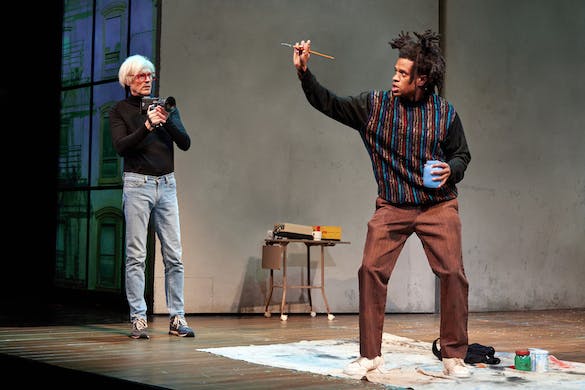The Warhol-Basquiat Bond Gets the Broadway Treatment
Even if ‘The Collaboration’ offers few fresh insights into their work or their bond, it’s an intriguing character study.

Few creative alliances have invited more speculation, both romantic and cynical, than that of Andy Warhol and Jean-Michel Basquiat. The decades since the American pop art pioneer and the graffiti artist-turned-neo-expressionist icon joined forces — just a few years before both died in the late 1980s — have seen a succession of accounts, from Julian Schnabel’s in the 1996 biopic “Basquiat” to the one presented in this year’s Netflix documentary series “The Andy Warhol Diaries.”
Now the playwright and screenwriter Anthony McCarten has his turn, with “The Collaboration,” arriving on Broadway after a London run. Mr. McCarten is also represented locally this season with a tribute to a very different cultural hero, the jukebox outing “A Beautiful Noise: The Neil Diamond Musical.” If “Collaboration,” predictably, delivers its mix of romance and cynicism with more sophistication, it can still flirt with clichés and overstatement.
To be sure, the pairing of Warhol and Basquiat — played here by Paul Bettany and Jeremy Pope, reprising their U.K. performances — summons stark contrasts. When they met, Basquiat was in his early 20s, a Black man of Haitian and Puerto Rican descent who despite a middle-class background (he had attended private school in his native Brooklyn for a spell) had known instability and demonstrated a rebellious streak during his youth.
Warhol, the son of white, working-class immigrants, got his start in publishing and advertising before emerging as a revolutionary figure in the art world, and then expanded the range of his projects and influence to include music and film. Commerce remained his inspiration, though, and his comfort with the commodification of art — a point of emphasis for Mr. McCarten — extended to the celebrity establishment that embraced him.
“He’s old hat,” Basquiat says dismissively, when the prospect of working with Warhol comes up in the play. “There’s no soul. I’m Dizzy Gillespie, blowing a riff; he’s one of those pianos that plays all by itself.”
Jazz becomes a metaphor for differences between the young, Black artist and the middle-aged veteran, whose partnership is portrayed, at least in its initial stages, as less organic and more contentious than other accounts have suggested. The play’s first image is of Mr. Bettany’s Warhol standing alone onstage, observing Basquiat’s early paintings — captured in Duncan McLean’s sleek projection design — as a Miles Davis riff plays behind him.
“It’s too much,” Warhol says of the paintings, adding, “They’re so ugly and angry and … kinda violent.” When he and Basquiat put aside their mutual misgivings and agree to a trial session — at the urging of renowned art dealer Bruno Bischofberger, played here by a droll Erik Jensen — the latter nearly pulls out after discovering Warhol isn’t a Davis fan. “Jazz, it goes on so loooong,” Mr. Bettany protests, deftly affecting his character’s deceptively gentle, dry speaking style.
Mr. McCarten stresses the role of race in differences between the artists, nodding to the horrific case of Michael Stewart, a Black graffiti artist whose death after sustaining injuries in police custody, in 1983, haunted Basquiat. Warhol refers to the “primal” nature of Basquiat’s work, quoting Mr. Schnabel, and tells his Black colleague that he needs to act “more civilized.”
It’s suggested that Basquiat’s erratic behavior also irritates the women in his life. There are a bunch, apparently, represented here by a crisply dressed, perpetually frustrated gal pal who happens to be pregnant. Although nicely played by a plucky Krysta Rodriguez, she’s an utter stereotype — the smart young woman who stupidly falls for a tortured, self-involved artist. “He’s so fragile, and vulnerable, and sweet, I just want to run a bath and wash him,” she coos.
For a while, Mr. McCarten seems to suggest there’s something purer about Basquiat and his approach. “World’s like one huge brand now…. We need to go to war against all that,” he announces, reprimanding Warhol. Yet in the end, the playwright’s portraits of both men, and of the disparities between them, become more nuanced.
Under Kwame Kwei-Armah’s direction, the leading actors manage a convincing and compelling rapport. Mr. Pope, whose lavish gifts as a musical performer have been on display in previous Broadway productions, physicalizes his character’s manic energy with grace and, when Basquiat is emotionally or perhaps chemically addled, poignance. There is pathos in Mr. Bettany’s performance as well — a pained, self-conscious quality lurking behind the sharp wit, suggesting Warhol’s reputed shyness and loneliness.
“I order you to live forever,” Warhol finally says to Basquiat. Both did, in a sense, and even if “The Collaboration” offers few fresh insights into their work or their bond, it’s an intriguing character study.

